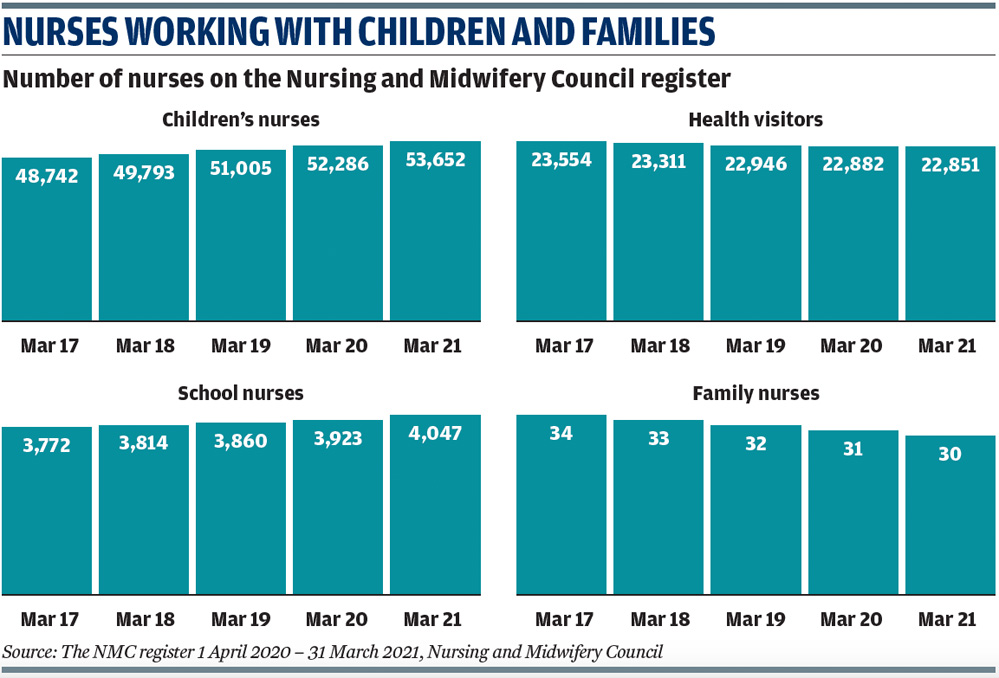
While the NHS remains the biggest employer of children’s health professionals, many work in multi-agency teams. In the children’s sector, roles cover a wide range of areas including nursing, midwifery, health visiting, paediatrics, mental health, substance misuse and sexual health.
Even before Covid, there were concerns about shortages of key healthcare staff, including those that work with the most vulnerable children and young people. A 2020 Royal College of Paediatrics and Child Health study found 10 per cent of neonatal units had gaps in medical staffing in 2019. However, there has been a recent surge of interest in entering health professions with a significant rise in recruitment for entry-level paediatrics positions. More than 97 per cent of posts were filled in England in 2020, up from just under 83 per cent in 2019.

Nursing
The number of registered nurses, midwives and nursing associates in the UK is at a record high, according to the Nursing and Midwifery Council (NMC), with over 15,000 more registered nurses, midwives and nursing associates in 2021 compared with March 2020. Applications for nursing courses have risen by almost a third – 32 per cent – to reach 60,130, according to UCAS.
The number of children’s nurses continued its steady annual rise to a new total of 53,652, and the number of registered school nurses has also risen from 3,923 in 2020 to 4,047 in 2021. However, the NMC has expressed concerns about the longer-term impact of Covid-19 on a workforce under pressure.
The NMC is currently consulting on new standards which will shape the education and ongoing development of a number of specialist nursing roles including health visitors, community children’s nurses and school nurses. Health Education England (HEE) will launch a blended learning degree in midwifery in 2022, delivered by four universities. Each university will provide practical experience close to home, while all other aspects of training will be delivered using technologies including Virtual Reality, Augmented Reality and gaming. HEE launched a similar blended nursing degree in 2020.
The nursing associate role aims to bridge the roles of healthcare assistant and registered nurse. HEE launched an ambassador scheme in December 2020 to raise awareness.
Health visitors
During the pandemic many health visitors were redeployed to help the NHS respond to the influx of coronavirus patients. Those who remained faced significantly increased caseloads. In England, the number of full-time equivalent health visitors continues to fall, standing at 6,595 in March 2021 –a 36 per cent drop since 2015, when numbers reached a record high. In its Start for Life review into early years health, published in March 2021, the government said it would work with partners including the NMC and HEE to promote health visiting as a career and ensure skilled health visitors were supported to stay in the profession.
Mental health
The Royal College of Psychiatrists found that 80,226 more children and young people were referred to mental health services between April and December 2020, up by 28 per cent on 2019. The NHS has sped up the roll out of its mental health support team (MHST) programme and aims to have around 400 mental health support teams covering 3,000 schools in England by 2023. Currently 183 teams are operational and a further 103 are in development.
MHSTs usually include four Education Mental Health Practitioners (EMHPs), who assess and support children and young people with common mental health difficulties, such as mild to moderate anxiety, depression, and behaviour difficulties. The role can include advising on sleep, problem solving and panic attacks, promoting approaches to improve emotional health and advising education staff. EMHPs undertake a funded 12-month university course combining academic and theory elements, self-study and work-based placements.
A voluntary register for EMHPs, Psychological Wellbeing Practitioners (PWPs) and Children’s Wellbeing Practitioners (CWPs) was approved in June 2021. A CWP is a specialist role in a child and adolescent mental health services team, delivering low-intensity psychological interventions for mild to moderate mood and anxiety disorders. A PWP is trained to assess and support people with common mental health problems to manage their own recovery and can specialise in perinatal work.
HEE is increasing training places for clinical psychology and child and adolescent psychotherapy by 25 per cent in 2021/22. Child and adolescent psychotherapists are employed by mental health trusts and undertake clinical placements. They must hold a degree, usually in psychology, then enter academic training that culminates with a doctoral level academic qualification alongside a clinical qualification.
Funding is available for around a third of schools and colleges to train a senior member of staff as a Senior Mental Health Lead between September 2021 and March 2022. Training will focus on the knowledge and skills to implement an effective whole school approach to mental health and wellbeing. The government has committed to offer senior mental health lead training to all state schools and colleges by 2025.
Charity YoungMinds offers a range of training courses covering issues such as adolescent mental health, trauma and adversity and mental health in younger years.

